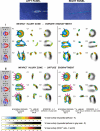Randomized transcoronary delivery of CD34(+) cells with perfusion versus stop-flow method in patients with recent myocardial infarction: Early cardiac retention of ⁹⁹(m)Tc-labeled cells activity
- PMID: 21161463
- PMCID: PMC3032199
- DOI: 10.1007/s12350-010-9326-z
Randomized transcoronary delivery of CD34(+) cells with perfusion versus stop-flow method in patients with recent myocardial infarction: Early cardiac retention of ⁹⁹(m)Tc-labeled cells activity
Abstract
Background: For transcoronary progenitor cells' administration, injections under flow arrest (over-the-wire balloon technique, OTW) are used universally despite lack of evidence for being required for cell delivery or being effective in stimulating myocardial engraftment. Flow-mediated endothelial rolling is mandatory for subsequent cell adhesion and extravasation.
Methods: To optimize cell directing toward the coronary endothelium under maintained flow, the authors developed a cell-delivery side-holed perfusion catheter (PC). Thirty-four patients (36-69 years, 30 men) with primary stent-assisted angioplasty-treated anterior MI (peak TnI 151 [53-356]ng/dL, mean[range]) were randomly assigned to OTW or PC autologous ⁹⁹Tc-extametazime-labeled bone marrow CD34(+) cells (4.34 [0.92-7.54] × 10⁶) administration at 6-14 days after pPCI (LVEF 37.1 [24-44]%). Myocardial perfusion (⁹⁹(m)Tc-MIBI) and labeled cells' activity were evaluated (SPECT) at, respectively, 36-48 h prior to and 60 min after delivery.
Results: In contrast to OTW coronary occlusions, no intolerance or ventricular arrhythmia occurred with PC cells' administration (P < .001). One hour after delivery, 4.86 [1.7-7.6]% and 5.05 [2.2-9.9]% activity was detected in the myocardium (OTW and PC, respectively, P = .84). Labeled cell activity was clearly limited to the (viable) peri-infarct zone in 88% patients, indicating that the infarct core zone may be largely inaccessible to transcoronary-administered cells.
Conclusions: Irrespective of the transcoronary delivery method, only ≈ 5% of native (i.e., non-engineered) CD34(+) cells spontaneously home to the injured myocardium, and cell retention occurs preferentially in the viable peri-infarct zone. Although the efficacy of cell delivery is not increased with the perfusion method, by avoiding provoking ischemic episodes PC offers a rational alternative to the OTW delivery.
Figures




References
-
- Lipinski MJ, Biondi-Zoccai GGL, Abbate A, Khianey R, Sheiban I, Bartunek J, et al. Impact of intracoronary cell therapy on left ventricular function in the setting of acute myocardial infarction. A meta-analysis of controlled clinical trials. J Am Coll Cardiol. 2007;50:1761–1767. doi: 10.1016/j.jacc.2007.07.041. - DOI - PubMed
-
- Tendera M, Wojakowski W, Ruzyllo W, Chojnowska L, Tracz W, Musiałek P, et al. Intracoronary infusion of bone marrow-derived selected CD34+CXCR4+ cells and non-selected mononuclear cells in patients with acute STEMI and reduced left ventricular ejection fraction. Results of REGENT Trial. Eur Heart J. 2009;30:1313–1321. doi: 10.1093/eurheartj/ehp073. - DOI - PubMed
-
- Musialek P, Tracz W, Skotnicki AB, Zmudka K, Pieniazek P, Walter Z, et al. Transcoronary stem cell delivery with the use of physiological endothelium-targeting perfusion technique: The rationale and a pilot study in patients after recent myocardial infarction. Pol Heart J. 2006;64:489–498. - PubMed
Publication types
MeSH terms
Substances
LinkOut - more resources
Full Text Sources
Other Literature Sources
Medical

